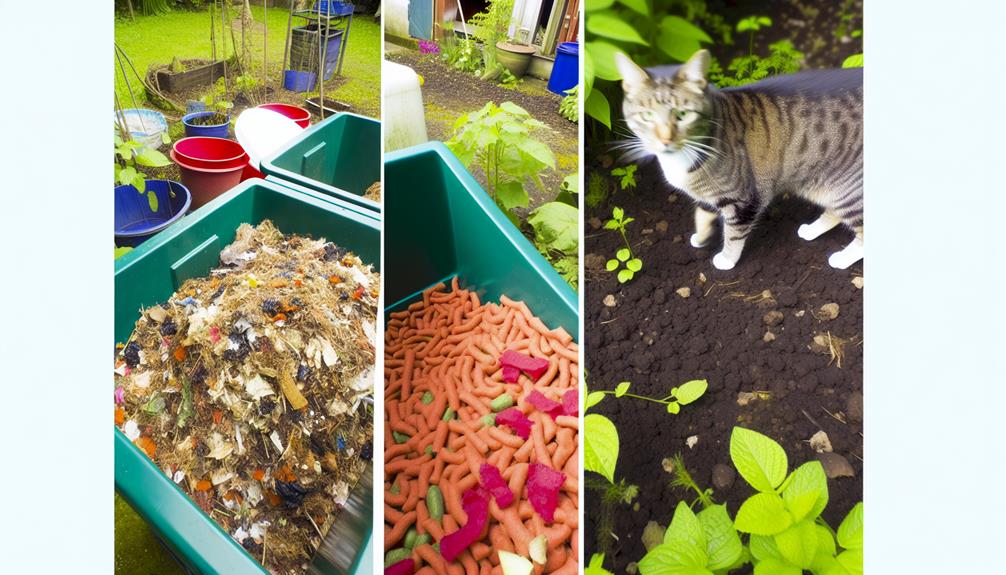

Yes, you can compost cat food, but it requires some care to do it right. Cat food is high in protein and fats, which can attract pests like rodents and emit strong odors, so you should bury it deep in the compost pile and balance it with plenty of carbon-rich materials like dry leaves.
Avoid composting large amounts, as it can disrupt the compost’s balance. Watch for non-compostable ingredients like synthetic vitamins and high salt content. Properly managed, composting cat food can reduce waste and create nutrient-rich soil, giving you a delightful composting experience. Want to explore more? Keep going!
Understanding what goes into your cat’s food is essential for both their health and effective composting. Cat food contains high levels of protein from sources like chicken, fish, and beef, ensuring your furry friend gets the nutrients they need.
It also includes grains, vegetables, vitamins, and minerals for a balanced diet. Don’t forget the fats, essential fatty acids, and amino acids that provide energy and support overall health.
The moisture content in cat food varies—dry kibble, semi-moist, or wet canned food all differ. Knowing these details helps you make informed choices about your cat’s diet and how to handle leftover food responsibly.
This knowledge fosters a sense of community and shared responsibility in pet care and environmental stewardship.
Also Read: Can You Compost Bag?
While understanding your cat’s food composition is essential, it’s also important to be aware of the risks involved in composting it.
Composting cat food can attract pests such as flies and rodents due to its strong odor. If not managed properly, this odor can become overwhelming, making your compost pile unpleasant.
The decomposition process of cat food requires careful monitoring; if not balanced with carbon-rich materials like dry leaves, it may not break down effectively. Burying cat food deep in the compost pile can help mitigate some of these issues, but it’s still essential to adjust the amount added to maintain a healthy balance.
Also Read: Can You Compost Aubergine?
When you compost cat food, you might notice it attracts pests like flies and rodents due to its strong odor. The high protein content speeds up decomposition but also makes the smell worse, luring unwanted wildlife to your compost pile.

To manage these issues, you can bury the cat food deep in the pile and balance it with carbon-rich materials like dry leaves, which helps reduce odors and keep pests at bay.
Burying decomposing cat food deep in your compost pile helps guarantee minimal odors and deters pests. As you know, pet food can attract pests like flies and rodents, which isn’t ideal for maintaining a clean and efficient compost system.
This can also have a broader environmental impact by luring unwanted wildlife into your yard. To counter this, make sure to balance your compost pile with plenty of carbon-rich materials like leaves and cardboard.
Regularly monitoring your compost pile guarantees it stays healthy and doesn’t become a magnet for critters. By taking these steps, you can compost cat food responsibly, contributing to a sustainable environment while keeping your compost pile effective and pest-free.
Decomposing cat food can create strong odors that attract unwanted pests to your compost pile. The high protein content in cat food speeds up the smelly decomposition process, leading to a more pungent composting experience. To minimize this, you should bury the cat food at least 6 inches deep in the pile. This helps contain the smell and keeps pests like flies and rodents away. Mixing it with carbon-rich materials, such as dry leaves or shredded paper, can further balance the decomposition and reduce odors.
Here’s a quick comparison:
| Problem | Solution | Outcome |
|---|---|---|
| Strong odors | Bury 6 inches deep | Reduced smell |
| Attracts pests | Mix with dry leaves | Fewer pests |
| Fast breakdown | Add shredded paper | Balanced decomposition |
This approach helps maintain a healthier compost environment.
Effectively managing odors and pests while composting cat food requires a few strategic steps. Burying cat food at least 6 inches deep in the compost pile can greatly minimize odors and deter pests.
To further reduce smells, mix the cat food with carbon-rich materials like dry leaves or shredded paper. Regularly monitor and turn the compost pile to guarantee proper aeration, which helps control odors tied to decomposing cat food.
Be mindful of the amount you add; too much can attract pests like flies and rodents. By balancing cat food with other compost materials and maintaining good aeration, you can keep your compost pile odor-free and pest-resistant, making your composting efforts both effective and enjoyable.
Also Read: Can You Compost Baking Soda?
When you’re composting, it’s important to be aware of the non-compostable ingredients often found in cat food. These ingredients can hinder the composting process and harm your compost pile. Non-compostable ingredients like synthetic vitamins and minerals don’t break down effectively.
Meat by-products, due to their density, can take longer to decompose and might attract pests.
Here are some common non-compostable ingredients to watch out for:
Also Read: Can You Compost Artichoke?
When it comes to proper disposal methods for cat food, you’ve got several eco-friendly options to contemplate.

You can explore pet food recycling programs that help reduce waste, or adopt techniques like mixing small amounts of cat food into your compost pile.
These methods not only benefit the environment but also guarantee that you’re managing waste responsibly.
Recycling pet food through composting is a practical way to reduce waste and benefit the environment. As pet owners, you can turn leftover pet food into compost by mixing it with other organic materials. This not only reduces landfill waste but also creates nutrient-rich soil for your garden.
Here are some recycling options to explore:
Properly disposing of cat food through eco-friendly techniques can greatly diminish your environmental footprint. Composting is an excellent option. By mixing cat food waste with green composting materials like vegetable scraps and leaves, you help create nutrient-rich soil. This process not only reduces landfill waste but also cuts down on greenhouse gas emissions.
The EPA supports composting as a sustainable way to manage pet food waste, enhancing your garden and promoting plant growth. When you compost, you’re contributing to a more environmentally friendly and sustainable future. Embrace this method to join a community dedicated to protecting our planet.
Let’s make a difference together by turning waste into valuable resources for our gardens!
To maintain a healthy compost, layer cat food with carbon-rich materials like dry leaves or shredded paper. This helps balance nitrogen-rich cat food with brown materials, essential for effective decomposition.
Guarantee your compost bin is well-aerated by turning the pile regularly. Using a moisture meter, keep an eye on the moisture level; it should feel like a damp sponge.
Burying the cat food at least 6 inches deep helps avoid odors and pests.
Also Read: Can You Compost Barbecue Sauce?
Consider donating unused or expired cat food to local animal shelters or rescues to reduce waste. This small act can make a significant difference and contribute to a sense of community.
If you can’t add pet food into your composting bin, there are other eco-friendly options. Some pet food brands offer biodegradable or compostable products, helping to reduce the amount of waste. Check with the EPA for information on environmentally friendly waste management practices.
Choosing eco-friendly cat food options can also minimize your environmental impact. By considering these alternatives, you not only help the environment but also support local shelters and reduce the strain on your composting bin. It’s a win-win for everyone involved!
When thinking about composting cat food, it’s important to also consider how to handle pet waste safely and effectively. Composting pet waste can be challenging due to potential pathogens, but with careful management, you can still contribute positively to the environment.
Ensuring the right moisture level in your compost pile is essential to promote decomposition and reduce odors.
Here are some key considerations:
Also Read: Can You Compost Basil?

Check with your local waste management department to understand the specific guidelines for composting cat food in your area. Some communities may have restrictions on composting pet food waste due to pest concerns. It is crucial to follow local waste management guidelines to guarantee proper decomposition and safety. Many municipalities offer composting programs designed to handle pet food waste efficiently. By adhering to these guidelines, you’re not just managing waste responsibly, but also contributing to sustainable practices in your community.
| Guideline | Details |
|---|---|
| Restrictions | May not allow animal products like cat food |
| Composting Programs | Inquire if local programs accept pet food waste |
| Safety Measures | Ensures proper decomposition and pest control |
| Environmental Impact | Supports sustainable waste management practices |
Following these steps helps create a cleaner, greener environment for everyone.
You can compost uneaten cat food by burying it 6 inches deep in your compost pile. Mix it with carbon-rich materials like dry leaves, and remember to turn the pile regularly. Alternatively, donate it to local animal shelters.
You shouldn’t compost meat, dairy, oily foods, or pet waste. These attract pests, create odors, and disrupt composting. Stick to plant-based materials to keep your compost healthy and your garden thriving. You’re part of a green community!
Yes, you can compost animal food. By doing so, you’re reducing waste and creating nutrient-rich soil. Just add small amounts gradually, mixing with organic materials. This practice nurtures your garden and supports a sustainable future.
You can dispose of cat food by composting it in your garden, donating unused portions to shelters, or opting for eco-friendly brands. Bury it deep in compost with carbon-rich materials to minimize odor and pests.
So, you can’t compost cat food, but don’t worry! There are better ways to dispose of it. By understanding cat food composition and the risks involved, you’ll avoid pests, odors, and non-compostable ingredients.
Stick to proper disposal methods and explore safe alternatives to composting. Always verify local waste management guidelines to make sure you’re protecting the environment.
With these tips, you’ll maintain a healthy compost and contribute to a cleaner, greener world.
